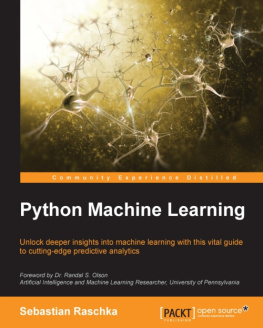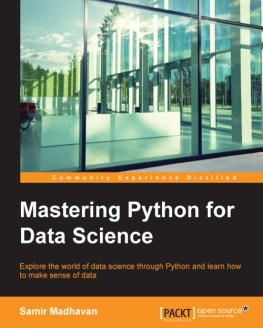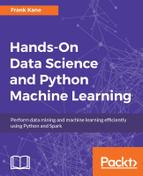Vickler - Python: Python For Data Science And Machine Learning
Here you can read online Vickler - Python: Python For Data Science And Machine Learning full text of the book (entire story) in english for free. Download pdf and epub, get meaning, cover and reviews about this ebook. year: 2021, genre: Romance novel. Description of the work, (preface) as well as reviews are available. Best literature library LitArk.com created for fans of good reading and offers a wide selection of genres:
Romance novel
Science fiction
Adventure
Detective
Science
History
Home and family
Prose
Art
Politics
Computer
Non-fiction
Religion
Business
Children
Humor
Choose a favorite category and find really read worthwhile books. Enjoy immersion in the world of imagination, feel the emotions of the characters or learn something new for yourself, make an fascinating discovery.

- Book:Python: Python For Data Science And Machine Learning
- Author:
- Genre:
- Year:2021
- Rating:4 / 5
- Favourites:Add to favourites
- Your mark:
- 80
- 1
- 2
- 3
- 4
- 5
Python: Python For Data Science And Machine Learning: summary, description and annotation
We offer to read an annotation, description, summary or preface (depends on what the author of the book "Python: Python For Data Science And Machine Learning" wrote himself). If you haven't found the necessary information about the book — write in the comments, we will try to find it.
Python: Python For Data Science And Machine Learning — read online for free the complete book (whole text) full work
Below is the text of the book, divided by pages. System saving the place of the last page read, allows you to conveniently read the book "Python: Python For Data Science And Machine Learning" online for free, without having to search again every time where you left off. Put a bookmark, and you can go to the page where you finished reading at any time.
Font size:
Interval:
Bookmark:
Python
Python for Data Science and Machine Learning
Copyright 2021 - All rights reserved.
The contents of this book may not be reproduced, duplicated, or transmitted without direct written permission from the author.
Under no circumstances will any legal responsibility or blame be held against the publisher for any reparation, damages, or monetary loss due to the information herein, either directly or indirectly.
Legal Notice:
You cannot amend, distribute, sell, use, quote, or paraphrase any part of the content within this book without the consent of the author.
Disclaimer Notice:
Please note the information contained within this document is for educational and entertainment purposes only. No warranties of any kind are expressed or implied. Readers acknowledge that the author is not engaging in the rendering of legal, financial, medical, or professional advice. Please consult a licensed professional before attempting any techniques outlined in this book.
By reading this document, the reader agrees that under no circumstances is the author responsible for any losses, direct or indirect, which are incurred as a result of the use of the information contained within this document, including, but not limited to, errors, omissions, or inaccuracies.
Table of Contents
Introduction
Thank you for purchasing this guide about data science and machine learning with Python. One of the first questions people ask is, what is data science? This is not a particularly easy question to answer because the term is widespread these days, used just about everywhere. Some say it is nothing more than an unnecessary label, given that science is all about data anyway, while others say it is just a buzzword.
However, many fail to see or choose to ignore because data science is quite possibly the ONLY label that could be given to the cross-discipline skill set that is fast becoming one of the most important in applications. It isn't possible to place data science firmly into one discipline; that much is definitely true. It comprises three areas, all distinct and all overlapping:
- Statistician these people are skilled in modeling datasets and summarizing them. This is an even more important skill set these days, given the ever-increasing size of today's datasets.
- Computer Scientist these people design algorithms and use them to store data, and process it, and visualize it efficiently.
- Domain Expertise - is akin to being classically trained in any subject, i.e. having expert knowledge. This is important to ensure the right questions are asked and the answers placed in the right context.
So, going by this, it wouldn't be remiss of me to encourage you to see data science as a set of skills you can learn and apply in your own expertise area, rather than being something new you have to learn from scratch. It doesn't matter if you are examining microspore images looking for microorganisms, forecasting returns on stocks, optimizing online ads to get more clicks or any other field where you work with data. This book will give you the fundamentals you need to learn to ask the right questions in your chosen expertise area.
Who This Book Is For
This book is aimed at those with experience of programming in Python, designed to help them further their skills and learn how to use their chosen programming language to go much further than before. It is not aimed at those with no experience of Python or programming, and I will not be giving you a primer on the language.
The book assumes that you already have experience defining and using functions, calling object methods, assigning variables, controlling program flow, and all the other basic Python tasks. It is designed to introduce you to the data science libraries in Python, such as NumPy, Pandas, Seaborn, Scikit-Learn, and so on, showing you how to use them to store and manipulate data and gain valuable insights you can use in your work.
Why Use Python?
Over the last few decades, Python has emerged as the best and most popular tool for analyzing and visualizing data, among other scientific tasks. When Python was first designed, it certainly wasn't with data science in mind. Instead, its use in these areas has come from the addition of third-party packages, including:
- NumPy for manipulating array-based data of the same kind
- Pandas for manipulating array-based data of different kinds
- SciPy for common tasks in scientific computing
- Matplotlib for high quality, accurate visualizations
- Scikit-Learn for machine learning
And so many more.
Python 2 vs. 3
The code used in this book follows the Python 3 syntax. Many enhancements are not backward compatible with Python 2, which is why you are always urged to install the latest Python version.
Despite Python 3 being released around 13 years ago, people have been slow to adopt it, especially in web development and scientific communities. This is mostly down to the third-party packages not being made compatible right from the start. However, from 2014, those packages started to become available in stable releases, and more people have begun to adopt Python 3.
What's in This Book?
This book has been separated into five sections, each focusing on a specific area:
- Part One introduces you to data science and machine learning
- Part Two focuses on NumPy and how to use it for storing and manipulating data arrays
- Part Three focuses on Pandas and how to use it for storing and manipulating columnar or labeled data arrays
- Part Four focuses on using Matplotlib and Seaborn for data visualization
- Part Five takes up approximately half of the book and focuses on machine learning, including a discussion on algorithms.
There is more to data science than all this, but these are the main areas you should focus on as you start your data science and machine learning journey.
Installation
Given that you should have experience in Python, I am assuming you already have Python on your machine. However, if you don't, there are several ways to install it, but Anaconda is the most common way. There are two versions of this:
- Miniconda provides you with the Python interpreter and conda, a command-line tool
- Anaconda provides conda and Python, along with many other packages aimed at data science. This is a much larger installation, so make sure you have plenty of free space.
It's also worth noting that the packages discussed in this book can be installed on top of Miniconda, so it's down to you which version you choose to install. If you choose Miniconda, you can use the following command to install all the packages you need:
[~]$ conda install numpy pandas scikit-learn matplotlib seaborn jupyter
All packages and tools can easily be installed with the following:
conda install packagename
ensuring you type the correct name in place of packagename.
Let's not waste any more time and dive into our introduction to data science and machine learning.
The definition of data science tells us that it is a research area used to derive valuable insight from data, and it does this using a theoretical method. In short, data science is a combination of simulation, technology, and market management.
Machine learning is a bit different. This is all about learning the data science techniques the computers use to learn from the data we give them. We use these technologies to gain outcomes without needing to program any specific laws.
Machine learning and data science are trending high these days and, although many people use the terms interchangeably, they are different. So, let's break this down and learn what we need to know to continue with the rest of the book.
Next pageFont size:
Interval:
Bookmark:
Similar books «Python: Python For Data Science And Machine Learning»
Look at similar books to Python: Python For Data Science And Machine Learning. We have selected literature similar in name and meaning in the hope of providing readers with more options to find new, interesting, not yet read works.
Discussion, reviews of the book Python: Python For Data Science And Machine Learning and just readers' own opinions. Leave your comments, write what you think about the work, its meaning or the main characters. Specify what exactly you liked and what you didn't like, and why you think so.



